World Cultural Heritage: Sannai Maruyama Site (Aomori Prefecture)
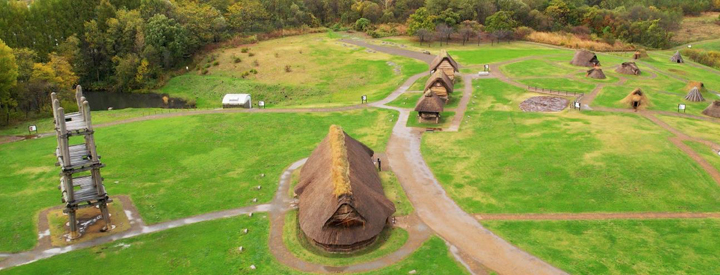
In July 2021 the Jomon prehistoric sites of Hokkaido and the northern Tohoku region of Japan were listed as UNESCO World Cultural Heritage. Ever since then I had wanted to visit and write about them, and recently the opportunity arose for me to go to and compile this report on the Sannai Maruyama Site, which was an especially large settlement among the 17 component places of the World Cultural Heritage and is the biggest Jomon site in Japan. On the day of my visit, I was able to speak with Mr. Yasuhiro Okada, who was involved in the large-scale excavation survey of the Sannai Maruyama Site, which began in 1992, right from the start and currently is director of the Sannai Maruyama Jomon Culture Center. Mr. Okada is also the author of some books I read before my visit. In addition, despite the poor weather forecast, it was a miraculously fine early morning, so we got our drone photography done and were fortunate enough to take some marvelous videos. Together with the text, I hope readers will enjoy viewing the videos of the Jomon site, which, viewed from above, appears just like a fairyland.
Video of the whole site: https://youtu.be/7KdmM0L2lRA
What is the Jomon period of Japanese history?
Since the dates of the Jomon period differ depending on the definition of Jomon culture, it is difficult to give a clear answer to this question. The two great inventions of the Jomon period are said to have been earthenware and the bow and arrow, and in modern textbooks it is written that the period began 15,000 years ago in around 13,000 BC. These textbooks do not say when the period ended, but it is generally said to be 2,400 years ago (400 BC).
Because of the rapid warming that began about 15,000 years ago, forests of deciduous broad-leaved trees like chestnut, walnut, and mizunara (Quercus crispula), which were highly nutritious and suitable for eating, formed, and the rise in sea levels created bays and inlets rich in fish and shellfish. This was an advantageous environment for hunter-gatherers, and when they became able to engage in cooking as well following the invention of earthenware, their range of food supplies expanded too. It was in places close to the sea or a river and with forests of deciduous broad-leaved trees offering abundant animal and plant life that the Jomon people came to reside.
Due to the climate at that time, many forests of deciduous broad-leaved trees grew in central to northeastern Japan. Such places also had salmon and trout swimming upstream and, because of the ocean current, a wealth of other fish and shellfish as well, so it was an ideal environment for the Jomon people. For this reason, around 80% of the population is said to have been concentrated in eastern Japan.
Position of the Sannai Maruyama Site in the Jomon period
The Sannai Maruyama settlement is said to have continued from around 3,900 BC to 2,200 BC. In terms of the six stages of the Jomon period, this corresponds to the middle of Early Jomon to the end of Middle Jomon. At first, due to warming, the average temperature was 2–3 degrees Celsius higher than today, and the sea level was up to 5 meters higher, so forests of deciduous broad-leaved trees grew in the vicinity of settlements built on fluvial terraces. People lived by gathering, fishing, and hunting, and they are thought to have cultivated especially highly nutritious trees, such as chestnuts and walnuts, for food. In response to changes in the natural environment and a decline in foodstuffs after the cooling trend began, settlements later shrunk in size and dispersed.
Buildings and daily life
Mr. Okada gave me a guided tour of the site and museum.
The Sannai Maruyama Site, Japan’s biggest Jomon site, is huge, covering an area of 36 hectares, and more than 600 remains of residential pit dwellings have been confirmed here. Most of them have a base diameter of about 4 meters, so it is thought that they housed single families. These pit dwellings were rebuilt over and over again, so it is not the case that 600 of them stood simultaneously. It seems likely that up to 500 people were living at the site at any one time.

Video of cluster of pit dwellings (reconstruction): https://youtu.be/vaw-qEQbJZM
Among the pit dwellings, traces of 13 large structures with a length of more than 10 meters have been found. Since these structures stood near the center of the settlement, there is a possibility that they were used as meeting places or joint workplaces. Among them, an especially large and long pit dwelling measuring 32 meters in length and 10 meters in width has been discovered and reconstructed for visitors to see. This building has an internal space of about 300 m2, so it could easily hold 300 people. It is thought that such a meeting place would have been necessary in the settlement’s heyday.
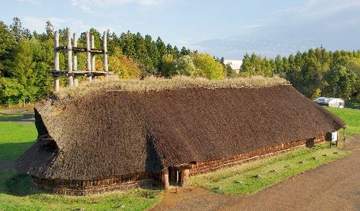
Video of large pit dwelling (reconstruction): https://youtu.be/4jIsGMoTPLQ
As another big building, the remains of a structure supported by six pillars standing in holes at intervals of 4.2 meters have been excavated. The pillar holes are enormous, with a diameter of 2 meters and depth of 2 meters. Because underground water meant that the pillars were not exposed to air, and because the Jomon people made use of their wisdom in preventing decaying by burning the surroundings and bottoms of pillars, the bottoms of chestnut pillars with a diameter of 1 meter have remained without any decay. To preserve these excavated pillar holes, they are covered by a dome, but visitors can freely view them. When I peered into the holes, I could see that spring water was accumulating even now. Regular drainage is necessary, I was told. The structure, which has been rebuilt nearby, greets visitors as a symbol of the site.
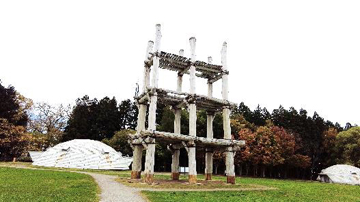
Video of large pillar-supported structure: https://youtu.be/kspCh2gXC3g
In addition, stilt-type buildings supported by six pillars dug into the ground were discovered standing closely together where the rows of adult graves near the center of the settlement come to an end. These graves stretch for 420 meters on both sides of a road leading from the eastern side of the settlement to the center. Since the buildings stood just beyond the graves, Mr. Okada said that although still uncertain, he thinks they are likely to have been facilities involved in funerals and burials.
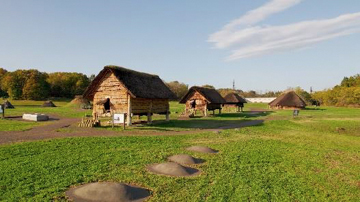
Video of pillar-supported (stilt-type) buildings: https://youtu.be/XaTZ3HZ-2M4
Diet
Rather than large animals like boar and deer, the Jomon people in this region are thought to have hunted smaller creatures like hare and flying squirrels. In addition, because of the site’s proximity to the sea and rivers, the bones of more than 50 species of fish have been discovered there. Like present-day people, the Jomon people ate such fish as horse mackerel, mackerel, sardines, and sea bream, and unearthed bones show that they consumed tuna from the Tsugaru Strait too. To catch the fish, they used fishing hooks, spears, and nets.
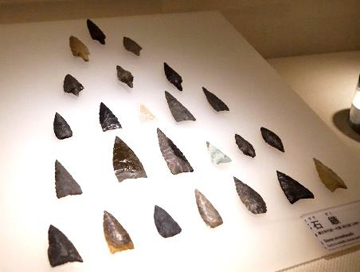
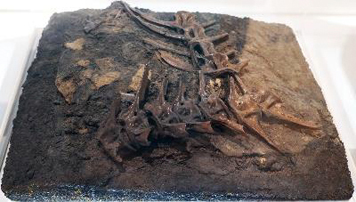
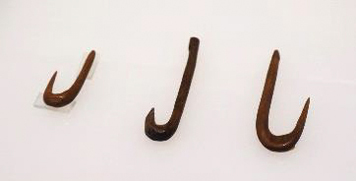
The bones of these fish and animals were discovered at a low-lying marsh called Kitanotani on the northern side of the site, near the Okidate River. This place served as a dumping ground, or midden, around the middle of the Early Jomon period. The conditions for preserving organic matter were excellent because the refuse was buried in the marsh and therefore did not come into contact with air. In terms of understanding the diet and daily life of the Jomon people, it was a precious find indeed.
Nevertheless, the fact is that the Jomon people did not consume very much animal protein; about 80% of their diet consisted of vegetables obtained from gathering.
Special mention should be made of the fact that chestnut and walnut trees, which were especially important sources of nutrition, were planted in the vicinity of the settlement. DNA analysis and other investigations have proved that chestnuts were managed in the Jomon days. Also, although this has nothing to do with diet, lacquered woodenware and earthenware have been unearthed at the site. Since lacquer in its natural state cannot be extracted from trees in large quantities, it is thought that lacquer must have been managed as well. In other words, although crop farming had not begun at the Sannai Maruyama Jomon settlement, the people there did engage in quasi-cultivation to control nature.
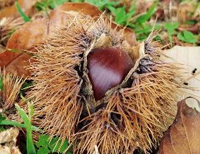
Video of a chestnut tree at the site: https://youtu.be/o64ODwiWyXo
Stoneware and earthenware
A lot of good quality shale, which is thin and easy to break off in layers, could be found in this district, so there was no shortage of material for stoneware.
The earthenware excavated at the Sannai Maruyama Site, called “cylindrical-style pottery,” was at first only used for cooking. But as time went on, the uses and types diversified.
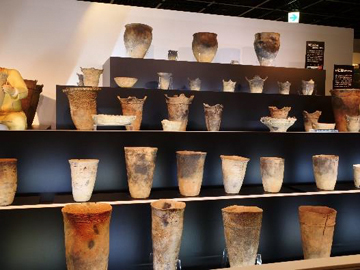
The clay and stone figurines, which are said to have been related to festivals, come in an abundant array of styles and sizes ranging from large to small; no two are the same. More than 2,000 figurines have been excavated at the Sannai Maruyama Site, which is relatively many more than at other sites. It is still not known what the figurines were used for, but almost all of them were in the form of women, so there seems to be no reason to deny the theory that they were used in festivals to pray for the blessings of nature, safe childbirth, and so on.
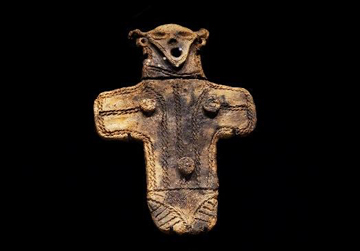
Video of Jomon earthenware repository: https://youtu.be/f3wI4M_MKyw
Exchange and trade
Several books that I had read prior to my visit suggested that the Jomon people might have had some kind of link with the continent. When I asked Mr. Okada about this possibility, his reply was, “There is no clear evidence.” There are many similarities, such as living in pit dwellings and using earthenware. But a decisive difference was the fact that at that time the crop farming of grains, such as barnyard millet, foxtail millet, and common millet, had already begun on the continent.
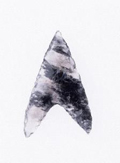
Obsidian from Nagano Prefecture Stone arrowhead (Sannai Maruyama Jomon Culture Center)
Regarding ties with distant places in Japan, there were clearly some traded items, such as obsidian from Nagano Prefecture and jade from Itoigawa in Niigata Prefecture. It is thought that there undoubtedly was a trading route via the Sea of Japan.
In addition, regarding relations with surrounding regions, many excavated items indicate a common cultural zone stretching north to Sapporo and the Chitose area in Hokkaido and south as far as Morioka and Akita. Exchange is thought to have been quite lively.

Jade from Itoigawa
Life-death view and rituals
There are dumping grounds, or middens, at Jomon sites. At the Sannai Maruyama Site there is a midden in a valley called Kitanotani. Because this valley is near a river and very marshy, animal and fish bones, plants, broken earthenware, and other items dating from the Jomon period have been unearthed here. As time passed, besides these middens, mounds also appeared. Excavations from these mounds have revealed not only soil discarded at the time of the settlement’s formation and daily life waste but also, mixed among the broken artifacts, many undamaged and still usable items and earthenware and clay figurines that were clearly destroyed intentionally. Traces of fires have also been discovered, and periodically the mounds were leveled by adding soil to create layers. One senses some kind of religious or ritualistic significance.

Section of mound taken from the south mound
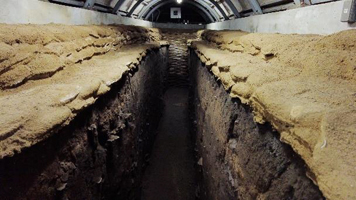
After removal of the section, the southern mound was covered for preservation and opened to the public.
Adult graves lined the roads in the settlement in an orderly manner. Situated away from the remains of dwellings, these places clearly were viewed as a separate world. Personally speaking, the rows of graves lining the roads leading from the world outside the settlement to the central part of the settlement seemed like not so much cemeteries as kind of monuments.
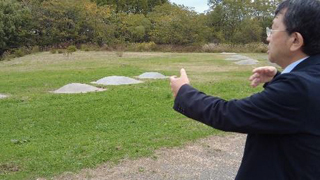
In addition, many children who died in their infancy were placed in earthen jars used for cooking and reused as coffins, and they were buried in group cemeteries relatively close to the dwellings. Since the settlement seems to have consoled the souls of children in almost the same ways, such as cutting holes in the earthenware pots and inserting round stones, the people possibly had a different sentiment, such as hope for rebirth, toward the death of children.
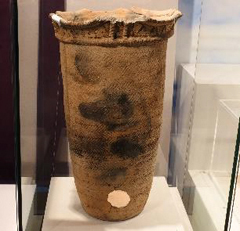
The stone circles with burials seem to have been made in the late Middle Jomon period. They are thought to indicate places where special people, such as patriarchs, were buried, although there is still no definite proof of this. Some of the large stone circles that appeared in the following Late Jomon period bear a resemblance to the stone circles with burials. There is also a theory that in the Late Jomon period the shrinking and dispersal of settlements advanced due to the cooling trend, and the large rows of stone circles were festive places not for individual settlements but for entire districts.
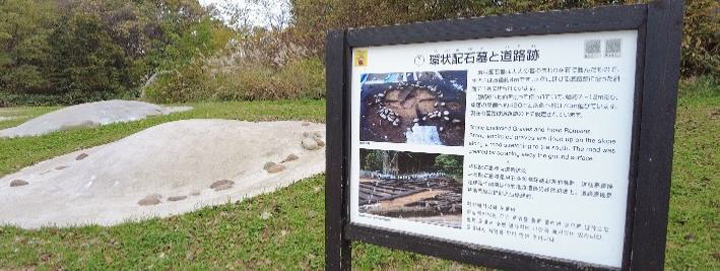
Surprises
I asked Mr. Okada what had surprised him about the Jomon people. The first thing he said in reply was, “There were no wars!” No weapons used in fighting have been discovered, there were no moats or trenches around the settlement, and there is no sign at all of many people having been killed collectively in battle. They probably had no need to fight. Mr. Okada said he thought that in their daily living the Jomon people possessed an image of humans as members of nature. And then, as if remembering something else, he added, “And I was surprised that when excavating at the site, we found so little garbage and waste.”
A lot of labor was surely necessary for building the large pillar-supported structure and other buildings, so there must have been many people working and others instructing them. And undoubtedly there were some who were buried in graves and others who were not, so it cannot be said that there were no social classes at all. But even so, I was told, there is no trace of any fighting.
Value as a heritage of humankind
I also asked Mr. Okada what he thought was the reason for the listing as World Cultural Heritage. He replied, “I think the concentration in this region of sites that can explain, as a single current, the daily life and spiritual culture of preagricultural human beings in Northeast Asia was recognized as a universal value.”
Afterword
The Jomon people were not simply folk who lived from day to day by hunting and gathering. They managed a yearly schedule related to gathering, fishing, and hunting and settled in places for a long time. They cleverly handled tools for fishing and hunting, and they even engaged in the cultivation of plants that were valuable sources of nutrition. Moreover, their scope of activity extended far beyond what I had imagined. They procured precious resources from distant places, skillfully processed them at large settlements like Sannai Maruyama, and then spread them to other settlements.
As Mr. Okada says, we cannot go back to the Jomon period. But the least we can do, I felt, is look at their relatively peaceful lifestyle in harmony with nature and reflect a little on the present-day destruction of the natural environment and the never-ending fighting.

The "Jomon pochette" excavated on the northern edge of the site - The woven basket and walnut found inside
Cooperation
Sannai Maruyama Jomon Culture Center
Address: 305 Sannai Maruyama, Aomori City, Aomori Prefecture 038-0031
Tel.: 017-781-6078 Fax: 017-781-6103
Website: https://sannaimaruyama.pref.aomori.jp/english/
Sannai Maruyama Jomon Culture Center and Jomon Jiyukan admission:
General: 410 yen; senior high school students, university students, etc.: 200 yen; junior high school students and under: free
Access: About 15 minutes by bus and 10 minutes by taxi from Shin-Aomori Station
References (in Japanese)
Jomon bunka to nihonjin (Jomon Culture and the Japanese; by Takaaki Sasaki)
Jomon dogu gaidobuku (Jomon Clay Figurines Guidebook; by Tetsuya Mikami)
Harukanaru Jomon no koe: Sannai Maruyama o horu (Distant Jomon Voices: Digging at Sannai Maruyama; by Yasuhiro Okada)
Sekai isan ni natta! Jomon iseki (Jomon Sites Become World Heritage! edited and compiled by Yasuhiro Okada)
Sannai Maruyama iseki gaidobuku (Sannai Maruyama Site Guidebook; digest edition)
- Category
- Culture、History、News、Travel、World Heritage
